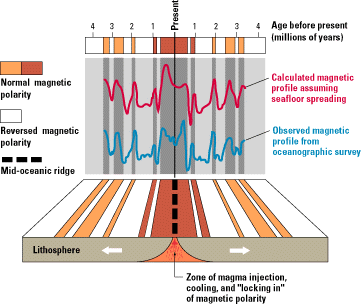
Magnetic stripes and isotopic clocks
Oceanographic exploration in the 1950s led to a much better understanding
of the ocean floor. Among the new findings was the discovery of zebra stripe-like
magnetic patterns for the rocks of the ocean floor. These patterns were
unlike any seen for continental rocks. Obviously, the ocean floor had a
story to tell, but what?
In 1962, scientists of the U.S. Naval Oceanographic Office prepared a report
summarizing available information on the magnetic stripes mapped for the
volcanic rocks making up the ocean floor. After digesting the data in this
report, along with other information, two young British geologists, Frederick
Vine and Drummond Matthews, and also Lawrence Morley of the Canadian Geological
Survey, suspected that the magnetic pattern was no accident. In 1963, they
hypothesized that the magnetic striping was produced by repeated reversals
of the Earth's magnetic field, not as earlier thought, by changes in intensity
of the magnetic field or by other causes. Field reversals had already been
demonstrated for magnetic rocks on the continents, and a logical next step
was to see if these continental magnetic reversals might be correlated in
geologic time with the oceanic magnetic striping. About the same time as
these exciting discoveries were being made on the ocean floor, new techniques
for determining the geologic ages of rocks ("dating") were also
developing rapidly.

An observed magnetic profile (blue) for the ocean floor across the East
Pacific Rise is matched quite well by a calculated profile (red) based on
the Earth's magnetic reversals for the past 4 million years and an assumed
constant rate of movement of ocean floor away from a hypothetical spreading
center (bottom). The remarkable similarity of these two profiles provided
one of the clinching arguments in support of the seafloor spreading hypothesis.
A team of U.S. Geological Survey scientists -- geophysicists Allan Cox and
Richard Doell, and isotope geochemist Brent Dalrymple -- reconstructed the
history of magnetic reversals for the past 4 million years using a dating
technique based on the isotopes of the chemical elements potassium and argon.
The potassium-argon technique -- like other "isotopic clocks"
-- works because certain elements, such as potassium, contain unstable,
parent radioactive isotopes that decay at a steady rate over geologic
time to produce daughter isotopes. The rate of decay is expressed
in terms of an element's "half-life," the time it takes for half
of the radioactive isotope of the element to decay. The decay of the radioactive
potassium isotope (potassium-40) yields a stable daughter isotope (argon-40),
which does not decay further. The age of a rock can be determined ("dated")
by measuring the total amount of potassium in the rock, the amount of the
remaining radioactive potassium-40 that has not decayed, and the amount
of argon-40. Potassium is found in common rock-forming minerals, and because
the potassium-40 isotope has a half-life of 1,310 million years, it can
be used in dating rocks millions of years old.
Other commonly used isotopic clocks are based on radioactive decay of certain
isotopes of the elements uranium, thorium, strontium, and rubidium. However,
it was the potassium-argon dating method that unlocked the riddle of the
magnetic striping on the ocean floor and provided convincing evidence for
the seafloor spreading hypothesis. Cox and his colleagues used this method
to date continental volcanic rocks from around the world. They also measured
the magnetic orientation of these same rocks, allowing them to assign ages
to the Earth's recent magnetic reversals. In 1966, Vine and Matthews --
and also Morley working independently -- compared these known ages of magnetic
reversals with the magnetic striping pattern found on the ocean floor. Assuming
that the ocean floor moved away from the spreading center at a rate of several
centimeters per year, they found there was a remarkable correlation between
the ages of the Earth's magnetic reversals and the striping pattern. Following
their break-through discovery, similar studies were repeated for other spreading
centers. Eventually, scientists were able to date and correlate the magnetic
striping patterns for nearly all of the ocean floor, parts of which are
as old as 180 million years.


